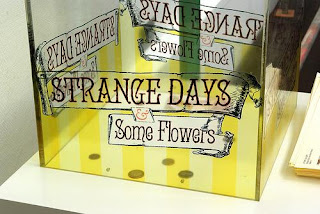 A couple of years ago while travelling around West Coast America, I accidentally came across this ghost town I have since learned is called Rhyolite. unlike other ghost towns I visited, it's none commercialised, and can be seen totally how it was when the last person left, exposing it to natural changes over time. It was so eery especially being situated within the hottest place on earth, and within an area titled 'Death Valley' due to these deathly humid and hot conditions. Very little animal life can be seen- very rarely maybe a snake, but no sound except the warm breeze can be heard. Adding some strange, contrasting forms to the naturally disguised homes and cars that have been deserted, is the Goldwell Open Air Museum including the Ghost sculptures shown below, which play upon the deserted area and the eery-ness of the town.
A couple of years ago while travelling around West Coast America, I accidentally came across this ghost town I have since learned is called Rhyolite. unlike other ghost towns I visited, it's none commercialised, and can be seen totally how it was when the last person left, exposing it to natural changes over time. It was so eery especially being situated within the hottest place on earth, and within an area titled 'Death Valley' due to these deathly humid and hot conditions. Very little animal life can be seen- very rarely maybe a snake, but no sound except the warm breeze can be heard. Adding some strange, contrasting forms to the naturally disguised homes and cars that have been deserted, is the Goldwell Open Air Museum including the Ghost sculptures shown below, which play upon the deserted area and the eery-ness of the town.
I have since learned that the town is becoming much more commercialised and promoted, which I'm disappointed about- Stumbling across the town allowed me to get a true feel for the atmosphere and a sense of discovery and exploration into a world where people once lived.
I have also just read that there are a range of films created there, including 'The Island' which was recently on TV. I wish I knew that before I watched it as I would have appreciated the setting a lot more. I'm not surprised to learn that other films such as 'The Arrogant', 'Ultraviolet' and 'Bone Dry' were filmed there, as its such an atmospheric place, and must save a lot of money rather than designing and creating an environment set from scratch.



 Despite this criticism of the Express as a result of advertorials, as marketing budgets become more strained, advertisers who are looking for better ways to make brands stand out are increasingly turning to advertorials. Justine Southall, publishing director of Cosmopolitan, says that last year was their best ever for advertorial features, and that this year they are on a similar track. Southall recognises the importance of the relationship between the reader and advertiser, as it can also effect attitudes towards the magazine. All advetorials must be clearly labelled, "[including] making sure the point size of the 'Cosmopolitan Promotion' is clearly legible." She also recognises that other publishers may be purposfully disguising promotions with unclear advertisement labelling, due to the current economic conditions, and says that "this is really dangerous for the long-term health of a brand."
Despite this criticism of the Express as a result of advertorials, as marketing budgets become more strained, advertisers who are looking for better ways to make brands stand out are increasingly turning to advertorials. Justine Southall, publishing director of Cosmopolitan, says that last year was their best ever for advertorial features, and that this year they are on a similar track. Southall recognises the importance of the relationship between the reader and advertiser, as it can also effect attitudes towards the magazine. All advetorials must be clearly labelled, "[including] making sure the point size of the 'Cosmopolitan Promotion' is clearly legible." She also recognises that other publishers may be purposfully disguising promotions with unclear advertisement labelling, due to the current economic conditions, and says that "this is really dangerous for the long-term health of a brand."


 David
David 